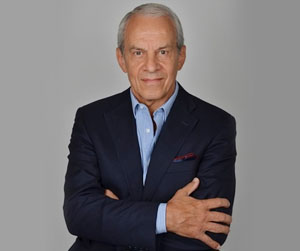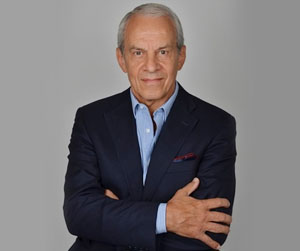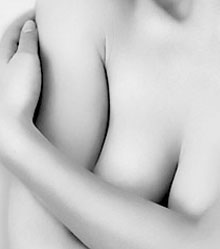Reduction of the areola
Large areola can be either constitutional, with tuberous breasts being one of the most common examples, but also due to pregnancies, large variations in weight or breast plastic surgery, often around the areola, which can cause this due to an increase in tension around the areola, secondary enlargement of the areola and a periareolar scar.
Areola reduction is frequently where the “Round Block" technique is used. This technique allows the skin around the areola to be normally repositioned, avoiding any enlargement or deformation of the areola, a major drawback of the old periareolar techniques. A deep periareolar support wire is put in place to control the diameter of the areola in the long term and to allow skin around the areola to adapt. This means there will only be a small circular periareolar scar, an area where scarring is usually of good quality and not very visible because the scar blends with the perimeter of the areola due to differences in colour and relief between the skin of the areola and the skin of the breast. This does not leave a vertical scar under the areola or in the sub-mammary fold. I have developed this "Round Block" technique in an effort to reduce scarring that often results from traditional plastic breast surgery.
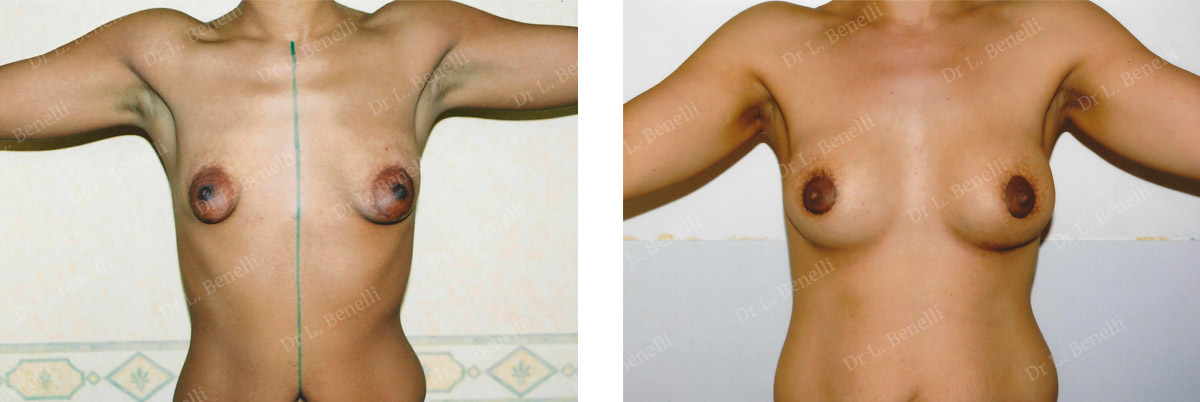
Reduction of the areola using the periareolar “Round Block” technique, with a volume increase using prosthesis.
Uses
Each person arrives with a request for correction of a particular defect that is particularly troublesome to them. The objective of the operation will be to correct this defect as a priority by assessing whether it may be appropriate to correct other associated defects to have a well-balanced, natural result that meets your expectations.
So, depending on the insights gained during the first consultation, the operation could possibly be combined with other procedures at the same time, such as breast augmentation, breast reduction, a breast liftor the correction of inverted nipples. These can be performed during the same procedure.
Consultation
During the first consultation, it is essential that you express freely what bothers you and what you expect to improve. Do not be afraid to expose all your questions, fears and expectations. Everyone is different in morphology, psychology, expectations are not the same, there is no standard.
After you have explained your motivations, I will examine you and offer one or more solutions, taking into account your expectations, your anatomy, respecting your identity and the harmony of your physique.
During the first consultation, I will evaluate the technique I will use, favouring the choice of a technique that will leave the least scarring.
So you can visualise the desired result, I will show you photos of surgical results from cases similar to yours to understand the objective of the intervention.
It is essential that you and I have a good understanding when deciding to operate and to determine the technique to use among from those I can offer.
I will then give you all the information on the techniques proposed along with the information sheets from the Société Française de Chirurgie Plastique Reconstructrice et Esthétique (French Society of Plastic, Reconstructive and Cosmetic Surgery) as well as a detailed estimate of the costs for the options chosen. You will then be able to move your project forwards and get ready for a second consultation when you will be able to ask any additional questions to help you make a decision and prepare for the operation.
Before the procedure
Pre-operative examinations should be performed:
-
Breast ultrasound and/or mammography to check breast health. These will allow any anomalies to be picked up and these may be treated during the operation or may possibly lead to additional pre-operative examinations.
-
A blood test, if necessary, depending on the type of anaesthesia (local or general).
In case of a general anaesthetic, you will need a consultation with the anaesthetist in the weeks preceding the operation and at least 48 hours before.
You will be prescribed a bra to buy, specifically for post-operative support. You must bring this with you on the day of the operation to worn at the end of the operation.
Recommendations:
No medications containing aspirin or anti-inflammatories can be taken within 10 days of the procedure.
For general anaesthetic, you will have to fast strictly for 6 hours before the operation (do not eat anything, chew gum, eat sweets or smoke).
Smoking can cause scarring problems.
The procedure
Hospitalisation and duration of the procedure:
In most cases, you will be able to go home the same day after a few hours of monitoring following the operation.
The procedure lasts about 45 minutes.
Type of anaesthetic:
Local, deep local (neuroleptanalgesia) or general according to your preferences.
Technique:
Before you go to the operating theatre, in your room, I will go over the precise goals with you as we agreed during the consultations. You can then always make recommendations and ask any questions. I will then draw the lines and marks on your skin to guide the operation and the lines of the incisions.
Correcting the size of the areola, to bring its diameter into balance with the volume of the breast is achieved using the “Round Block" technique.
This technique allows the skin around the areola to be repositioned. To avoid any enlargement or deformation of the areola, a major drawback of the old periareolar techniques, a deep periareolar support wire is put in place to support the diameter of the areola over the long term and allow the skin around the areola to adapt. Therefore, only a simple circular periareolar scar is made in an area where scarring is usually of good quality and not very visible because the scar blends with the perimeter of the areola due to differences in colour and relief between the skin of the areola and the skin of the breast. There is no vertical scar under the areola or in the sub-mammary fold. I have developed this "Round Block" technique in an effort to reduce scarring often entailed in traditional plastic breast surgery.
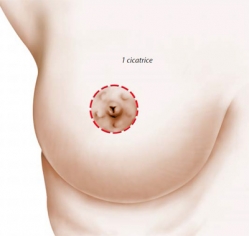
In particular, areola enlargements can occur as a result of plastic breast surgery in cases where too much skin has been removed from around the areola, which, after the operation, resulted in an increase in the tension on the areola and, therefore, a secondary enlargement of the areola and periareolar scar. These cases are more difficult to treat because there is no longer enough skin to cover the breast without an increase in tension. Therefore, it will be necessary to use a double "Round Block", firmly anchored deep in the periareolar skin, therefore protecting the areola and the periareolar scar from excess tension, which will be supported by the breast skin around the areola. After a few days or weeks, under the effect of this tension, the breast skin will expand and increase its range, so it ends up covering the breast without too much tension over the long term. This will limit the risks of secondary areola enlargement.
In rare cases, if this attempt fails to correct the areola under tension, it may be necessary to add a vertical scar under the areola in addition to the periareolar scar.
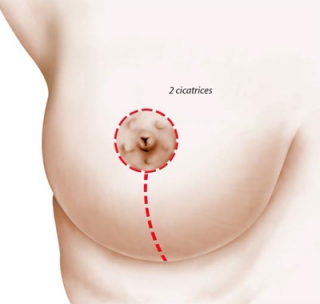
The deep internal stitch, which prevents areola enlargement or deformation, both major disadvantages of the old periareolar techniques, is made using a deeply rooted periareolar support wire ("Round Block"), which is set up to support the diameter of the areola over the long term and to allow the skin around the areola to adapt as much as possible, leaving only simple circular periareolar scar.
The stitches on the surface of the skin are made using threads placed in the thickness of the skin (intradermal stitches), which are, therefore, invisible. These stitches are absorbable and do not need to be removed.
At the end of the operation, a bandage is applied to the scar and a support bra is put in place.
After the operation
During the night and the days following the operation, there may be a painful sensation of tension in the area that was operated on, including aches and pains, which may impede your mobility. These pains are moderate in a resting position and may require analgesics that are given through a drip during hospitalisation or are taken as tablets at home. These post-operative pains will diminish and disappear within a few days of the operation.
The drainage will be removed the day after the operation.
The dressing will be completely removed during the first post-operative consultation, about a week after the operation and replaced by a waterproof adhesive dressing, allowing you to shower. This must be changed every 8 days.
The stitches used are absorbable, so they do not need to be removed. Placed internally within the skin’s thickness (intradermal stitch), they are invisible.
Swelling (oedema) and bruising in the chest area are usually very moderate and it takes about ten days for them to disappear almost completely.
You will need to take about a day off work after the operation in most cases.
Care:
In addition to wearing the support bra day and night for 1 month, you will need to use a waterproof dressing for taking showers, which should be changed every 8 days over a period of 1 month.
You will need to attend a follow-up consultation about a week after the procedure, then at 15 days, 1 month, 3 months, 6 months, and 1 year.
Recommendations:
-
Do not raise your arms too high and avoid heavy physical exertion.
-
You may resume sporting activities about 1 month after the operation, a support bra and limiting yourself to painless movements.
-
The recommended rest position is lying on your back, slightly raised if possible. You may also lie on your side but must not lie on your front.
-
Exposure to the sun: no direct exposure before 1 month then exposure is possible using a sun protection cream with a maximum sun protection factor. No exposure as long as there are bruises or the scar is pink.
-
Pregnancy and breastfeeding: Breastfeeding is possible. However, it is advisable to wait for 6 months before considering a pregnancy so that the breast can will be in its final form.
The result
The result is immediately visible despite any swelling and will improve in the weeks following the operation.
In the long term, in the vast majority of cases, the result will be stable and sustainable.
In addition to an aesthetic improvement, this operation has a beneficial impact on the patient's personal balance and development.
Risks and complications
Price range
The cost of the operation will depend on the procedure to be carried out, the duration of the operation, the type of anaesthetic and any hospital charges.
If the reason for the operation is purely aesthetic, you will not be entitled to reimbursement through social security. On the other hand, if this is for reconstruction after an accident or illness, there may be coverage under social security and, if necessary, by your mutual insurance company.
On the other hand, if the reason for the operation is purely aesthetic, you do not have the right to social security reimbursement.
A detailed estimate is given to you during the first consultation according to the options chosen. You then have a minimum legal period of 15 days to reflect and take your project forward.
The first consultation costs €50. The following consultations, before and after the operation, are free.
The photographs on this page are here to illustrate and complete the information given on the operations. They are merely for information purposes so you can see the goals, results and scars from the operation.
The likelihood of scarring and each patient’s individual anatomy are different. Therefore, for this reason, the photographs on this site do not commit Dr. Benelli to providing all patients with a similar result.
The information given on a site is not sufficient in itself and a medical consultation is essential to get the right information for each individual case. For this, you’ll need to consult a surgeon qualified in Plastic Reconstructive and Aesthetic Surgery.
